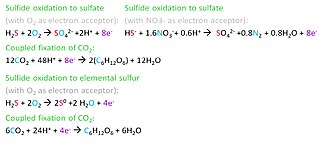Related Research Articles

Purple bacteria or purple photosynthetic bacteria are Gram-negative proteobacteria that are phototrophic, capable of producing their own food via photosynthesis. They are pigmented with bacteriochlorophyll a or b, together with various carotenoids, which give them colours ranging between purple, red, brown, and orange. They may be divided into two groups – purple sulfur bacteria and purple non-sulfur bacteria (Rhodospirillaceae). Purple bacteria are anoxygenic phototrophs widely spread in nature, but especially in aquatic environments, where there are anoxic conditions that favor the synthesis of their pigments.
Adenylyl-sulfate reductase (thioredoxin) is an enzyme that catalyzes the chemical reaction

Thiosulfate dehydrogenase is an enzyme that catalyzes the chemical reaction:

In enzymology, a sulfate adenylyltransferase is an enzyme that catalyzes the chemical reaction
[NiFe] hydrogenase is a type of hydrogenase, which is an oxidative enzyme that reversibly converts molecular hydrogen in prokaryotes including Bacteria and Archaea. The catalytic site on the enzyme provides simple hydrogen-metabolizing microorganisms a redox mechanism by which to store and utilize energy via the reaction shown in Figure 1. This is particularly essential for the anaerobic, sulfate-reducing bacteria of the genus Desulfovibrio as well as pathogenic organisms Escherichia coli and Helicobacter pylori. The mechanisms, maturation, and function of [NiFe] hydrogenases are actively being researched for applications to the hydrogen economy and as potential antibiotic targets.
Marichromatium is a genus in the phylum Pseudomonadota (Bacteria). The name Marichromatium derives from: Latin mare, the sea; New Latin Chromatium, a genus name; to give Marichromatium, the Chromatium of the sea, the truly marine Chromatium.

Microbial oxidation of sulfur is the oxidation of sulfur by microorganisms to build their structural components. The oxidation of inorganic compounds is the strategy primarily used by chemolithotrophic microorganisms to obtain energy to survive, grow and reproduce. Some inorganic forms of reduced sulfur, mainly sulfide (H2S/HS−) and elemental sulfur (S0), can be oxidized by chemolithotrophic sulfur-oxidizing prokaryotes, usually coupled to the reduction of energy-rich oxygen (O2) or nitrate (NO3−). Anaerobic sulfur oxidizers include photolithoautotrophs that obtain their energy from sunlight, hydrogen from sulfide, and carbon from carbon dioxide (CO2).

The hydrothermal vent microbial community includes all unicellular organisms that live and reproduce in a chemically distinct area around hydrothermal vents. These include organisms in the microbial mat, free floating cells, or bacteria in an endosymbiotic relationship with animals. Chemolithoautotrophic bacteria derive nutrients and energy from the geological activity at Hydrothermal vents to fix carbon into organic forms. Viruses are also a part of the hydrothermal vent microbial community and their influence on the microbial ecology in these ecosystems is a burgeoning field of research.
Allochromatium humboldtianum is a Gram-negative and motile bacterium from the genus of Allochromatium which has been isolated from shallow water and coastal sediments from the coast of Callao in Peru.
Allochromatium phaeobacterium is a phototrophic and rod-shaped purple sulfur bacterium from the genus of Allochromatium which has been isolated from brackish water in Bheemli, Visakhapatnam, India.
Allochromatium renukae is a Gram-negative and phototrophic bacterium from the genus of Allochromatium which has been isolated from brackish water from Chollangi in India.
Isochromatium is a Gram-negative, obligately phototrophic and strictly anaerobic genus of bacteria from the family of Chromatiaceae with one known species.